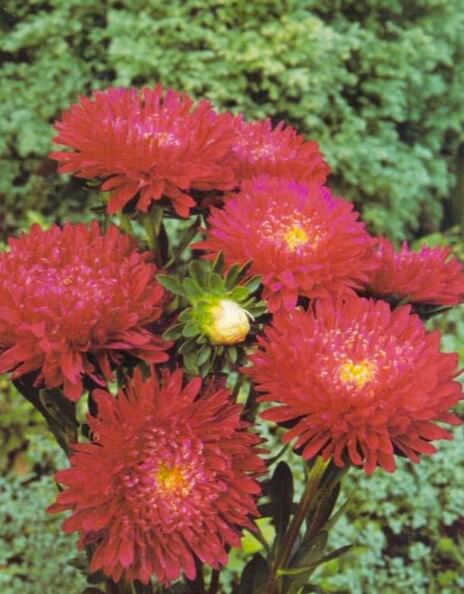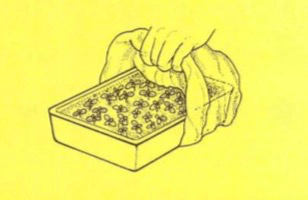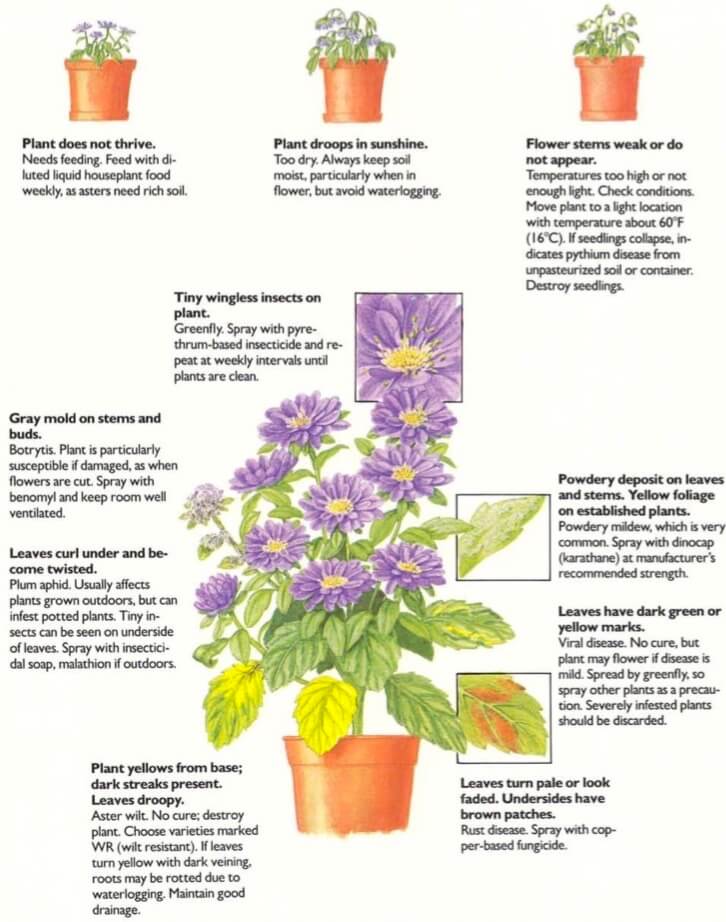[Ebook Việt Hoá] The Instant Guide to Healthy Houseplants (Hướng dẫn tức thời để chăm cây trong nhà khoẻ mạnh), Chi Callistephus
[Ebook Việt Hoá] The Instant Guide to Healthy Houseplants: Callistephus chinensis (China aster)
- Nguồn: [Ebook Việt Hoá] The Instant Guide to Healthy Houseplants (Hướng dẫn tức thời để chăm cây trong nhà khoẻ mạnh)
- Biên tập: Dũng Cá Xinh
- Biên dịch: Team Codai.net
English
This beautiful flower can be grown either indoors as a potted plant or outdoors for long-lasting cut flowers, providing the right cultivated variety (cultivar) is selected. The dwarf ‘Pinocchio’ is best for pots, while the medium-sized ‘Milady’ is good for both pots and cuttings. Its main requirements are plenty of sunshine (though it will stand shade for part of the day), a fairly rich soil and a constant supply of moisture when flowering. Outdoors it will survive light frosts; indoors it needs a cool, airy location. It has an unfortunate susceptibility to wilt disease; but if grown in pasteurized loam or soilless media, this should not be a problem indoors.

Light
Needs good light at all times, with full sun for most of the day if possible.
Temperature
Germinate seed at 55-60°F (13-1 6°C). Once potted, plants do best at a maximum of 60°F (16°C)
Water
Keep soil barely moist during germination and for seedlings. Young plants should be watered twice a week. Water copiously during bud stage and flowering.
Humidity
Cool, airy situation is best. In hot weather (over 70°F, 21°C), spray early or late in the day.
Feeding
Begin feeding 3 weeks after potting, using diluted liquid feed at manufacturer’s recommended strength. Feed weekly until flowering is finished .
Soil
Use seed potting soil (or all-purpose potting soil) for germination. Pot into loam-based or soilless potting media Always use pasteurized, not garden,soil.
After flowering
Flowers can be cut for vases, but plants will not flower again. Discard after flowering is finished.
Propagation
Sow seed in early spring; cover with 1/5 inch (3 mm) of soil. Cover with plastic bag pulled taut so it does not touch soil; remove bag when first signs of growth show. Give full light after 5 days and thin out 2 inches (5 cm) apart 14 days after sowing.

What Goes Wrong

- Plant does not thrive: Needs feeding. Feed with di- luted liquid houseplant food weekly, as asters need rich soil.
- Plant droops in sunshine: Too dry. Always keep soil moist, particularly when in flower, but avoid water logging.
- Flower stems weak or do not appear: Temperatures too high or not enough light. Check conditions. Move plant to a light location with temperature about 60°F (16°C). If seedlings collapse, indicates pythium disease from unpasteurized soil or container. Destroy seedlings.
- Tiny wingless insects on plant: Greenfly. Spray with pyrethrum-based insecticide and re-peat at weekly intervals until plants are clean.
- Gray mold on stems and buds: Botrytis. Plant is particularly susceptible if damaged, as when flowers are cut. Spray with benomyl and keep room well ventilated.
- Leaves curl under and become twisted: Plum aphid. Usually affects plants grown outdoors, but can infest potted plants. Tiny in- sects can be seen on underside of leaves. Spray with insecticidal soap, malathion if outdoors.
- Plant yellows from base; dark streaks present, leaves droopy: Aster wilt. No cure; destroy plant. Choose varieties marked WR (wilt reSistant). If leaves turn yellow with dark veining, roots may be rotted due to waterlogging. Maintain good drainage.
- Powdery deposit on leaves and stems, yellow foliage on established plants: Powdery mildew, which is very common. Spray with dinocap (karathane) at manufacturer’s recommended strength.
- Leaves have dark green or yellow marks: Viral disease. No cure, but plant may flower if disease is mild. Spread by greenfly, so spray other plants as a precaution. Severely infested plants should be discarded.
- Leaves turn pale or look faded, Undersides have brown patches: Rust disease. Spray with cop- per-based fungicide.
Tiếng Việt

Ánh sáng
Luôn luôn cần ánh sáng tốt và ánh nắng mặt trời đầy đủ.
Nhiệt độ
Hạt nảy mầm ở 55-60 ° F (13-1 6 ° C). Sau khi trồng trong chậu, cây phát triển tốt nhất ở nhiệt độ tối đa là 60 ° F (16 ° C)
Nước
Giữ đất vừa đủ ẩm cho cây con và trong quá trình nảy mầm. Cây còn nhỏ nên tưới 2 lần / tuần. Tưới nhiều nước trong giai đoạn ra nụ và ra hoa.
Độ ẩm
Vị trí mát mẻ, thông thoáng là tốt nhất. Khi thời tiết nóng (trên 70 ° F, 21 ° C), phun sớm hoặc muộn trong ngày.
Bón phân
Bắt đầu bón phân 3 tuần sau khi thay chậu, sử dụng phân bón dạng lỏng và pha loãng với cường độ khuyến cáo của nhà sản xuất. Bón phân hàng tuần cho đến khi ra hoa kết thúc.
Đất
Use seed potting soil (or all-purpose potting soil) for germination. Pot into loam-based or soilless potting media Always use pasteurized, not garden,soil.
Sau khi ra hoa
Có thể ngắt hoa để cắm lọ nhưng cây sẽ không ra hoa nữa. Bỏ cây đi sau khi ra hoa xong.
Nhân giống
Gieo hạt vào đầu mùa xuân; phủ 1/5 inch (3 mm) đất. Đậy bằng túi ni lông kéo căng để không chạm đất; loại bỏ túi khi có dấu hiệu tăng trưởng đầu tiên. Cung cấp ánh sáng đầy đủ sau 5 ngày và tỉa thưa cách nhau 2 inch (5 cm) sau 14 ngày sau khi gieo.

Những vấn đề có thể xảy ra

- Cây không phát triển: Cần bón phân. Sử dụng phân bón hữu cơ dạng lỏng pha loãng hàng tuần, vì Cúc tây cần đất giàu dinh dưỡng.
- Cây rũ xuống dưới ánh nắng: Quá khô. Luôn giữ ẩm cho đất, đặc biệt là khi cây ra hoa, nhưng tránh để cây bị úng.
- Cành hoa yếu hoặc không xuất hiện: Nhiệt độ quá cao hoặc không đủ ánh sáng. Kiểm tra các điều kiện. Di chuyển cây đến nơi có ánh sáng với nhiệt độ khoảng 60 ° F (16 ° C). Nếu cây con bị gãy đổ, chứng tỏ bệnh pythium từ đất hoặc thùng chứa chưa được khử trùng. Tiêu hủy cây con.
- Côn trùng nhỏ không cánh trên thực vật: Côn trùng phá hoại cây. Phun thuốc trừ sâu pyrethrum và đắp lại than bùn định kỳ hàng tuần cho đến khi cây sạch.
- Mốc xám trên thân và chồi: Nấm mốc. Cây đặc biệt dễ bị tổn thương nếu bị hư hại, như khi hoa bị cắt. Xịt bằng benomyl và giữ cho phòng thông thoáng.
- Các lá cuộn dưới và trở nên xoắn lại: Rệp. Thường ảnh hưởng đến cây trồng ngoài trời, nhưng có thể gây hại cho cây trồng trong chậu. Các mảng nhỏ có thể được nhìn thấy ở mặt dưới của lá. Phun xà phòng diệt côn trùng malathion nếu ở ngoài trời.
- Cây vàng từ gốc; có vệt sẫm màu, lá rũ xuống: Cúc tây bị héo. Không có thuốc chữa; phá hủy cây. Chọn các giống được đánh dấu WR (chống héo). Nếu lá chuyển sang màu vàng với những đường gân sẫm màu, rễ có thể bị thối rữa do úng nước. Duy trì hệ thống thoát nước tốt.
- Bệnh phấn trắng trên lá và thân, vàng lá trên các cây đã lớn: Bệnh phấn trắng, rất phổ biến. Xịt bằng dinocap (karathane) ở cường độ khuyến cáo của nhà sản xuất.
- Lá có vết xanh đậm hoặc vàng: Bệnh do virus. Không có thuốc chữa, nhưng cây có thể ra hoa nếu bệnh nhẹ. Do ruồi xanh lây lan, vì vậy hãy phun thuốc cho các cây khác để phòng ngừa. Những cây bị nhiễm bệnh nặng nên loại bỏ.
- Lá nhợt nhạt hoặc nhạt màu, Mặt dưới có những mảng màu nâu: Bệnh gỉ sắt. Phun thuốc trừ nấm.
![[Ebook Việt Hoá] The Instant Guide to Healthy Houseplants: Callistephus chinensis (China aster) [Ebook Việt Hoá] The Instant Guide to Healthy Houseplants: Callistephus chinensis (China aster)](https://vn1.vdrive.vn/codai.net/2020/02/ebook-huong-dan-tuc-thoi-cham-cay-trong-nha-khoe-manh-59-callistephus-chinensis.jpg)


